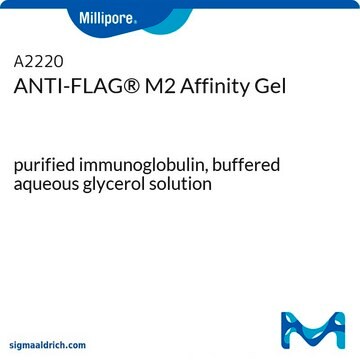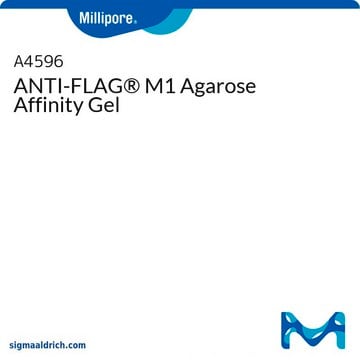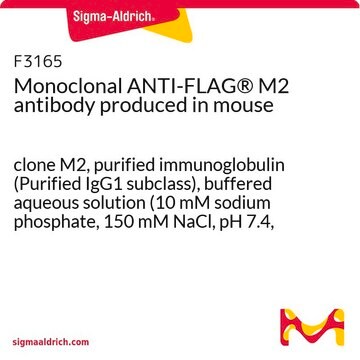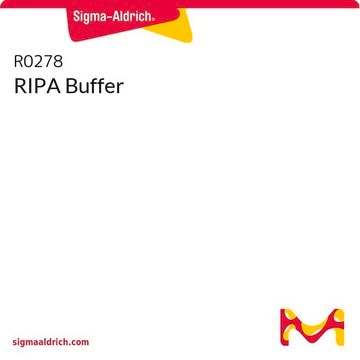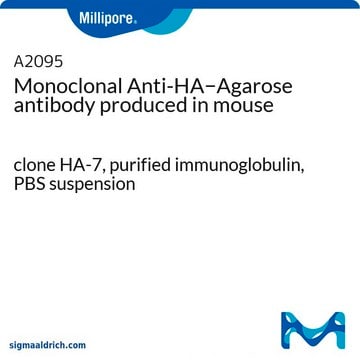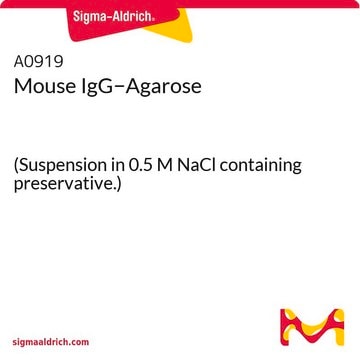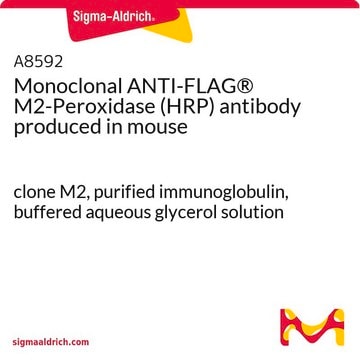The binding capacity of the resin must be ? 0.6 mg/mL to meet specifications. This capacity will vary from lot to lot.
Wichtige Dokumente
F2426
EZview™ Red ANTI-FLAG® M2-Affinitätsgel
clone M2
Synonym(e):
Monoklonaler ANTI-FLAG® M2-Antikörper in Maus hergestellte Antikörper, Anti-ddddk, Anti-dykddddk
Größe auswählen
About This Item
Empfohlene Produkte
Klon
M2, monoclonal
Qualitätsniveau
chemische Klasse(n) des Analyten
proteins
Methode(n)
affinity chromatography: suitable
immunoprecipitation (IP): suitable
Matrix
4% agarose bead; 45-165μm bead size
Isotyp
IgG1
Kapazität
≥0.6 mg/mL, gel binding capacity
Versandbedingung
wet ice
Lagertemp.
−20°C
Suchen Sie nach ähnlichen Produkten? Aufrufen Leitfaden zum Produktvergleich
Allgemeine Beschreibung
Spezifität
Anwendung
Elution – FLAG-Peptid, Glycin, pH 3,5, 3xFLAG-Peptid
Weitere Produktinformationen finden Sie in unserem FLAG® Literatur-Portal.
Physikalische Form
Rechtliche Hinweise
Haftungsausschluss
Ähnliches Produkt
Lagerklassenschlüssel
10 - Combustible liquids
WGK
WGK 3
Flammpunkt (°F)
Not applicable
Flammpunkt (°C)
Not applicable
Hier finden Sie alle aktuellen Versionen:
Analysenzertifikate (COA)
Die passende Version wird nicht angezeigt?
Wenn Sie eine bestimmte Version benötigen, können Sie anhand der Lot- oder Chargennummer nach einem spezifischen Zertifikat suchen.
Besitzen Sie dieses Produkt bereits?
In der Dokumentenbibliothek finden Sie die Dokumentation zu den Produkten, die Sie kürzlich erworben haben.
Kunden haben sich ebenfalls angesehen
Protokolle
Protocol for immunoprecipitation (IP) of FLAG fusion proteins using M2 monoclonal antibody 4% agarose affinity gels
Protokoll für die Immunpräzipitation (IP) von FLAG-Fusionsproteinen unter Einsatz des monoklonalen M2-Antikörper-Affinitätsgels (4 % Agarose)
Verwandter Inhalt
Protein purification techniques, reagents, and protocols for purifying recombinant proteins using methods including, ion-exchange, size-exclusion, and protein affinity chromatography.
Proteinaufreinigungsverfahren, Reagenzien und Protokolle zur Aufreinigung rekombinanter Proteine unter Anwendung von Methoden wie Ionenaustausch, Größenausschluss und Proteinaffinitätschromatographie.
Proteinexpressionstechnologien für verschiedene Expressionssysteme zur Unterstützung von Forschung und der Herstellung von Arzneimitteln und Impfstoffen.
Protein expression technologies for various expression systems supporting research, therapeutics, and vaccine production.
-
What is the binding capacity of the Product F2426, EZview™ Red ANTI-FLAG® M2 Affinity Gel clone M2, resin?
1 Antwort-
Hilfreich?
-
-
When using Product F2426, EZview™ Red ANTI-FLAG® M2 Affinity Gel clone M2, should I use a 3X FLAG peptide or a 1X FLAG peptide to elute my protein?
1 Antwort-
If you have a 3X FLAG-tagged protein, then you will need to use the 3X FLAG peptide. If you have a 1X FLAG-tagged protein, you can use the 1X FLAG peptide or the 3X FLAG peptide. We have not noticed a significant difference in elution efficiency by using a 3X FLAG peptide on a 1X FLAG-tagged protein.
Hilfreich?
-
-
When using Product F2426, EZview™ Red ANTI-FLAG® M2 Affinity Gel clone M2, I see bands at 20-25 kDa and 50-60 kDa appearing in my Westerns that are not my FLAG-tagged protein. How can I prevent this?
1 Antwort-
As a result of the conjugation, there may be some M2 antibody that is not conjugated to the resin, but is associated with the resin and may appear in acid elutions as heavy and light chain when using the anti-mouse IgG conjugated secondary antibody. We recommend a acid wash (0.1 M glycine-HCL pH 3.5) and neutralization of the resin (do not allow the acid wash to sit on the resin longer than 20 minutes) prior to applying the lysate. Another way to avoid this is to use a directly conjugated FLAG antibody for detection such as product A8592 ant-FLAG M2 HRP, or the rabbit anti-FLAG polyclonal antibody, F7425.
Hilfreich?
-
-
When using Product F2426, EZview™ Red ANTI-FLAG® M2 Affinity Gel clone M2, I have a lot of non-specific proteins that are eluting with my FLAG-tagged protein. How can I get rid of these?
1 Antwort-
One way to remove non-specific proteins is to pre-bind the protein lysate with unconjugated resin. We recommend product 4B200 for this purpose. Other methods would be to increase the stringency of the washes by increasing salt concentration (the resin can tolerate up to 1M NaCl) or including detergents that are compatible with the resin.
Hilfreich?
-
-
When using Product F2426, EZview™ Red ANTI-FLAG® M2 Affinity Gel clone M2, how can I elute my protein?
1 Antwort-
Elution with the peptide is the most gentle method. Acid elution (0.1 M glycine-HCL pH 3.5) is a more stringent method of elution, and should be evaluated for its effect on your protein if it is to be used in downstream applications. Boiling the resin in sample buffer is the most denaturing condition. If this condition is used, the resin cannot be re-used, due to the presence of SDS and/or reducing agents.
Hilfreich?
-
-
What is the Department of Transportation shipping information for this product?
1 Antwort-
Transportation information can be found in Section 14 of the product's (M)SDS.To access the shipping information for this material, use the link on the product detail page for the product.
Hilfreich?
-
Aktive Filter
Unser Team von Wissenschaftlern verfügt über Erfahrung in allen Forschungsbereichen einschließlich Life Science, Materialwissenschaften, chemischer Synthese, Chromatographie, Analytik und vielen mehr..
Setzen Sie sich mit dem technischen Dienst in Verbindung.